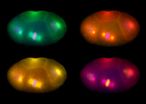INFORMATION:
The study was funded by the National Institutes of Health grant RO1HL087103.
Co-authors of the study are Thomas C. Register, Ph.D., Susan E. Appt, D.V.M., and Thomas B. Clarkson, D.V.M. of Wake Forest Baptist.
Common antidepressant increased coronary atherosclerosis in animal model
2015-04-06
(Press-News.org) WINSTON-SALEM, N.C. - April 6, 2015 - A commonly prescribed antidepressant caused up to a six-fold increase in atherosclerosis plaque in the coronary arteries of non-human primates, according to a study by researchers at Wake Forest Baptist Medical Center. Coronary artery atherosclerosis is the primary cause of heart attacks.
The study is published in the current online issue of the journal Psychosomatic Medicine.
"The medical community has known for years that depression is closely associated with heart disease, but we didn't know if treating it would reduce the heart disease risk," said Carol Shively, Ph.D., professor of pathology/comparative medicine at Wake Forest Baptist and lead author of the study.
In the study, 42 middle-aged female monkeys were fed a Western-like diet containing fat and cholesterol for 18 months. During this pre-treatment phase, depressive behavior in the animals was recorded.
Female animals were chosen for the study because coronary heart disease is the leading cause of death in women in the United States, and depressive disorders are twice as likely in women as in men.
The animals were then randomly assigned to receive a commonly prescribed antidepressant, a selective serotonin reuptake inhibitor (SSRI) marketed under the brand name Zoloft, or a placebo once a day for 18 months. The antidepressant was given in a dose comparable to that given to patients.
The monkeys that received the SSRI developed three times the amount of atherosclerosis in their coronary arteries as monkeys given the placebo. In the depressed animals, the amount was even higher - almost six times greater in the SSRI-treated animals than in those given the placebo.
"Our findings suggest that long-term treatment with this drug promotes coronary artery atherosclerosis in non-human primates," Shively said. "This may be clinically significant for people because almost a quarter of middle-aged women in the United States take antidepressants, the most prescribed of which are SSRIs."
Shively added that although more research is needed, doctors may want to keep these findings in mind when they are prescribing antidepressants. Previous studies have shown that exercise and counseling may be as effective as SSRIs in treating depression for many people.
ELSE PRESS RELEASES FROM THIS DATE:
Characteristic pattern of protein deposits in brains of retired NFL players who suffered concussions
2015-04-06
A new UCLA study takes another step toward the early understanding of a degenerative brain condition called chronic traumatic encephalopathy, or CTE, which affects athletes in contact sports who are exposed to repetitive brain injuries. Using a new imaging tool, researchers found a strikingly similar pattern of abnormal protein deposits in the brains of retired NFL players who suffered from concussions.
The innovative imaging technique uses a chemical marker combined with positron emission tomography, or PET scan, and was initially tested in five retired NFL players ...
New research complicates seismic hazard for British Columbia, Alaska region
2015-04-06
SAN FRANCISCO--The Pacific and North America plate boundary off the coast of British Columbia and southeastern Alaska is a complex system of faults capable of producing very large earthquakes. The recent 2012 Mw 7.8 Haida Gwaii and 2013 Mw 7.5 Craig earthquakes released strain built up over years, but did not release strain along the Queen Charlotte Fault, which remains the likely source of a future large earthquake, according to reports published in a special issue of the Bulletin of the Seismological Society of America (BSSA).
"The study of these two quakes revealed ...
Study identifies protein that triggers lupus-associated immune system activation
2015-04-06
Massachusetts General Hospital (MGH) investigators have identified an inflammatory molecule that appears to play an essential role in the autoimmune disorder systemic lupus erythematosus, commonly known as lupus. In their report being published online in Nature Immunology, the researchers describe finding that a protein that regulates certain cells in the innate immune system - the body's first line of defense against infection - activates a molecular pathway known to be associated with lupus and that the protein's activity is required for the development of lupus symptoms ...
Better sensors for medical imaging, contraband detection
2015-04-06
MIT researchers have developed a new, ultrasensitive magnetic-field detector that is 1,000 times more energy-efficient than its predecessors. It could lead to miniaturized, battery-powered devices for medical and materials imaging, contraband detection, and even geological exploration.
Magnetic-field detectors, or magnetometers, are already used for all those applications. But existing technologies have drawbacks: Some rely on gas-filled chambers; others work only in narrow frequency bands, limiting their utility.
Synthetic diamonds with nitrogen vacancies (NVs) -- ...
Researchers track protein 'hitchhiker' in fluorescent worms
2015-04-06
Dividing cells--whether they're in an embryo or an adult--rely on the right processes happening at the right time to turn out healthy.
Now, researchers at the University of Iowa have identified a mechanism that dividing cells in worms use to ensure their proper development, and they believe the same process could be going on in humans. The mechanism, unknown until now, describes one part of the cell, called the centrosome, as an "internal timekeeper"--like a train conductor. A crucial protein in charge of gene expression, beta-catenin, is described as a "hitchhiker"--it ...
Working up a sweat -- it could save your life
2015-04-06
Physical activity that makes you puff and sweat is key to avoiding an early death, a large Australian study of middle-aged and older adults has found.
The researchers followed 204,542 people for more than six years, and compared those who engaged in only moderate activity (such as gentle swimming, social tennis, or household chores) with those who included at least some vigorous activity (such as jogging, aerobics or competitive tennis).
They found that the risk of mortality for those who included some vigorous activity was 9 to 13 per cent lower, compared with those ...
We can fix the Great Barrier Reef
2015-04-06
Leading coral reef scientists say Australia could restore the Great Barrier Reef to its former glory through better policies that focus on science, protection and conservation.
In a paper published in the journal Nature Climate Change, the authors argue that all the stressors on the Reef need to be reduced for it to recover.
An Australian Government report into the state of the Great Barrier Reef found that its condition in 2014 was "poor and expected to further deteriorate in the future". In the past 40 years, the Reef has lost more than half of its coral cover and ...
Many nursing home residents die, don't walk after lower extremity revascularization
2015-04-06
Many nursing home residents who underwent lower extremity revascularization died, did not walk or had functional decline following the procedure, which is commonly used to treat leg pain caused by peripheral arterial disease, wounds that will not heal or worsening gangrene, according to an article published online by JAMA Internal Medicine.
Lower extremity revascularization is often performed so patients with peripheral arterial disease can maintain the ability to walk, which is a key component of functional independence. But outcomes among patients with high levels of ...
Neurologic function, temperature management in patients after cardiac arrest
2015-04-06
Quality of life was good and cognitive function was similar in patients with cardiac arrest who received targeted body-temperature management as a neuroprotective measure in intensive care units in Europe and Australia, according to an article published online by JAMA Neurology.
Brain injury is the primary cause of death for patients treated in intensive care units after suffering cardiac arrest (CA) outside of a hospital. Targeted temperature management (TTM) has been implemented as a neuroprotective treatment for comatose CA survivors because of reports of improved ...
Using pediatric cholesterol guidelines for teens, young adults would increase statin use
2015-04-06
Application of pediatric guidelines for lipid levels for persons 17 to 21 years of age who have elevated low-density lipoprotein cholesterol (LDL-C) levels would result in statin treatment for more than 400,000 additional young people than the adult guidelines, according to an article published online by JAMA Pediatrics.
Adolescence is a common time for the emergence of risk factors for cardiovascular disease, including abnormal cholesterol levels. The 2011 National Heart, Lung, and Blood Institute Integrated Guidelines for Cardiovascular Health and Risk Reduction in ...


